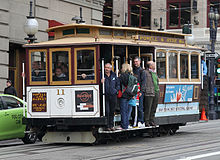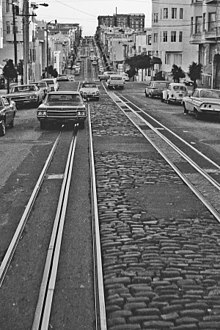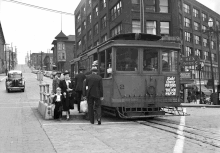Cable car (railway)

A cable car (usually known as a cable tram outside North America) is a type of cable railway used for mass transit in which rail cars are hauled by a continuously moving cable running at a constant speed. Individual cars stop and start by releasing and gripping this cable as required. Cable cars are distinct from funiculars, where the cars are permanently attached to the cable.
History


The first cable-operated railway, employing a moving rope that could be picked up or released by a
In 1869 P. G. T. Beauregard demonstrated a cable car at New Orleans[6][7][8] and was issued U.S. patent 97,343.
Other cable cars to use grips were those of the Clay Street Hill Railroad, which later became part of the San Francisco cable car system. The building of this line was promoted by Andrew Smith Hallidie with design work by William Eppelsheimer, and it was first tested in 1873. The success of these grips ensured that this line became the model for other cable car transit systems, and this model is often known as the Hallidie Cable Car.
In 1881 the Dunedin cable tramway system opened in Dunedin, New Zealand and became the first such system outside San Francisco. For Dunedin, George Smith Duncan further developed the Hallidie model, introducing the pull curve and the slot brake; the former was a way to pull cars through a curve, since Dunedin's curves were too sharp to allow coasting, while the latter forced a wedge down into the cable slot to stop the car. Both of these innovations were generally adopted by other cities, including San Francisco.
In Australia, the Melbourne cable tramway system operated from 1885 to 1940. It was one of the most extensive in the world with 1200 trams and trailers operating over 15 routes with 103 km (64 miles) of track. Sydney also had a couple of cable tram routes.
Cable cars rapidly spread to other cities, although the major attraction for most was the ability to displace
For example, the Chicago City Railway, also designed by Eppelsheimer, opened in Chicago in 1882 and went on to become the largest and most profitable cable car system. As with many cities, the problem in flat Chicago was not one of incline, but of transportation capacity. This caused a different approach to the combination of grip car and trailer. Rather than using a grip car and single trailer, as many cities did, or combining the grip and trailer into a single car, like San Francisco's California Cars, Chicago used grip cars to pull trains of up to three trailers.
In 1883 the

On 25 September 1883, a test of a cable car system was held by
Though some new cable car systems were still being built, by 1890 the cheaper to construct and simpler to operate electrically-powered trolley or tram started to become the norm, and eventually started to replace existing cable car systems. For a while hybrid cable/electric systems operated, for example in Chicago where electric cars had to be pulled by grip cars through the loop area, due to the lack of trolley wires there. Eventually, San Francisco became the only street-running manually operated system to survive—Dunedin, the second city with such cars, was also the second-last city to operate them, closing down in 1957.
Recent revival
In the last decades of the 20th-century, cable traction in general has seen a limited revival as
Operation


The cable is itself powered by a stationary engine or motor situated in a cable house or power house. The speed at which it moves is relatively constant depending on the number of units gripping the cable at any given time.
The cable car begins moving when a clamping device attached to the car, called a grip, applies pressure to ("grip") the moving cable. Conversely, the car is stopped by releasing pressure on the cable (with or without completely detaching) and applying the brakes. This gripping and releasing action may be manual, as was the case in all early cable car systems, or automatic, as is the case in some recent cable operated people mover type systems. Gripping must be applied evenly and gradually in order to avoid bringing the car to cable speed too quickly and unacceptably jarring passengers.
In the case of manual systems, the grip resembles a very large pair of pliers, and considerable strength and skill are required to operate the car. As many early cable car operators discovered the hard way, if the grip is not applied properly, it can damage the cable, or even worse, become entangled in the cable. In the latter case, the cable car may not be able to stop and can wreak havoc along its route until the cable house realizes the mishap and halts the cable.[10]
One apparent advantage of the cable car is its relative energy efficiency. This is due to the economy of centrally located power stations, and the ability of descending cars to transfer energy to ascending cars. However, this advantage is totally negated by the relatively large energy consumption required to simply move the cable over and under the numerous guide rollers and around the many
Because of the constant and relatively low speed, a cable car's potential to cause harm in an accident can be underestimated. Even with a cable car traveling at only 14 km/h (9 mph), the mass of the cable car and the combined strength and speed of the cable can cause extensive damage in a collision.
Relation to funiculars
A cable car is superficially similar to a funicular, but differs from such a system in that its cars are not permanently attached to the cable and can stop independently, whereas a funicular has cars that are permanently attached to the propulsion cable, which is itself stopped and started. A cable car cannot climb as steep a grade as a funicular, but many more cars can be operated with a single cable, making it more flexible, and allowing a higher capacity. During the rush hour on San Francisco's Market Street Railway in 1883, a car would leave the terminal every 15 seconds.[12]
A few funicular railways operate in street traffic, and because of this operation are often incorrectly described as cable cars. Examples of such operation, and the consequent confusion, are:
- The Great Orme Tramway in Llandudno, Wales.
- Several street funiculars in Lisbon, Portugal.
Even more confusingly, a hybrid cable car/funicular line once existed in the form of the original Wellington Cable Car, in the New Zealand city of Wellington. This line had both a continuous loop haulage cable that the cars gripped using a cable car gripper, and a balance cable permanently attached to both cars over an undriven pulley at the top of the line. The descending car gripped the haulage cable and was pulled downhill, in turn pulling the ascending car (which remained ungripped) uphill by the balance cable. This line was rebuilt in 1979 and is now a standard funicular, although it retains its old cable car name.
List of cable car systems
Cities currently operating cable cars
Traditional cable car systems
The best-known existing cable car system is the
Modern cable car systems
Several cities operate a modern version of the cable car system. These systems are fully automated and run on their own reserved right of way. They are commonly referred to as people movers, although that term is also applied to systems with other forms of propulsion, including funicular style cable propulsion.
These cities include:
- Oakland, California, United States – The Oakland Airport Connector system between the BART rapid transit system and Oakland International Airport, based on Doppelmayr Cable Car's Cable Liner Pinched Loop
- Shanghai, China - The Bund Sightseeing Tunnel, based on Soulé's SK
- Doppelmayr Cable Car's Cable LinerPinched Loop
- OTIS's Otis Hovair
Cities previously operating cable cars
Australia

- Melbourne (1885–1940, the Melbourne cable tramway system)
- Sydney (1886–1905)
France
Lebanon
- Beirut (Late 1880s until destruction during the Lebanese Civil War)
New Zealand
- Dunedin (1881–1957, the Dunedin cable tramway system)
- Wellington (1902–1979, the original Wellington Cable Car hybrid system)
Philippines
- Manila (Early 1900s-1930s, the Manila-Malabon railway.)
Portugal
- Lisbon (converted to regular tram lines in the early 20th century: São Sebastião, Estrela, and Graça)
United Kingdom
- electric traction)
- Edinburgh (Edinburgh Corporation Tramways, 1899–1923, converted to electric traction)
- Glasgow (Glasgow Subway, 1896–1935, converted to electric traction)
- Hastings
- Liverpool (trial in 1883)
- London, England (1884–1909, Highgate Hill Cable Tramway connecting Archway with Highgate, the first cable car in regular operation in Europe)
- Matlock (1893–1927, the Matlock Cable Tramway)
Isle of Man
- Douglas (1896–1929, the Upper Douglas Cable Tramway)
United States

- Baltimore, Maryland(1890–1897)
- Binghamton, New York (trial in 1885)
- Brooklyn, New York
- New York and Brooklyn Bridge Railway
- Brooklyn Cable Company's Park Avenue Line
- Brooklyn Heights Railroad's Montague Street Line
- Butte, Montana (1889–1897)
- Chicago, Illinois (1882–1906)
- Chicago City Railway
- North Chicago Street Railroad
- West Chicago Street Railroad
- Cincinnati, Ohio
- Cleveland, Ohio
- Denver, Colorado (1886–1900, the Denver Tramway)
- Grand Rapids, Michigan
- Hoboken Elevated)
- Kansas City, Missouri (1885–1913), including 9th St Incline (1888–1902), 8th St. Tunnel in use (1887–1956)
- Temple Street Cable Railway, (1889–1896) Los Angeles Cable Railway
- New York City
- Ninth Avenue Line
- New York and Brooklyn Bridge Railway
- 125th Street Crosstown Line
- Third Avenue Railroad's Third Avenue Line
- Broadway Line
- Metropolitan Street Railway's Broadway and Columbus Avenue Line
- Metropolitan Street Railway's Broadway and Lexington Avenue Line
- IRT Ninth Avenue Line (defunct)
- Newark, New Jersey (1888–1889)
- Oakland, California (1886–1899)
- Omaha, Nebraska
- Philadelphia, Pennsylvania
- Pittsburgh, Pennsylvania
- Portland, Oregon (1890–1904)
- Providence, Rhode Island (1888–1895)
- St. Louis, Missouri
- Saint Paul, Minnesota
- San Diego, California (1890–1892)
- Seattle, Washington (1888–1940)[15]
- Sioux City, Iowa
- Spokane, Washington (1899–1936)
- Tacoma, Washington (1891–1938)[16]
- Tulsa, Oklahoma
- Washington, D.C. (1890–1899, part of the Washington streetcar system)
- Wichita, Kansas
See also
References
- Specific
- ^ Hilton, George W. (1971). The Cable Car in America. Berkeley, CA.: Howell NorthBooks.
- ^ "The Cable in Chicago: Speeding along the Streets Rapid Transit there for Miles". The Baltimore Sun, page 8. Nov 9, 1889.
- ^ Erskine Hazard, Observations upon Rail-roads, The Franklin Journal and American Mechanics' Magazine, Vol. III, No. 4 (April 1827); page 275.
- ^ Fawdon Wagonway, Structural Images of the North East Archived 2012-09-02 at the Wayback Machine, University of Newcastle upon Tyne, 26 Mar. 2004.
- ^ Robertson, Andrew (March 1848). "Blackwall Railway Machinery". The Civil Engineer and Architect's Journal. 11. New York: Wiley & Putnam.
- ISBN 9781879714021.
- ISBN 9781455612598.
- ^ "St. Charles Avenue Streetcar Line, 1835". Archived from the original on 2016-12-20. Retrieved 2016-03-29.
- ISBN 1-85669-241-8.
- ISBN 9780809338108. Archivedfrom the original on 2024-02-07. Retrieved 2023-03-18.
- ^ Source: San Francisco Municipal Railway
- ISBN 9781909815247.
- ^ "POMA" (in French). Transports Urbain Laonnois. Archived from the original on 2009-04-21. Retrieved 2009-04-02.
- ^ Hilton (1982), p. 167.
- ^ Hilton (1982), pp. 389–407.
- ^ Hilton (1982), p. 465.
- General
- ISBN 0-8047-3051-2.
- Of Cables and Grips: The Cable Cars of San Francisco, by Robert Callwell and Walter Rice, published by Friends of the Cable Car Museum, first edition, 2000.
- Chicago Cable Cars, by Greg Borzo, published by The History Press (2012), ISBN 978-1-60949-327-1
External links
Information
- Cable Car Museum
- Cable Car Guy
- a scripophily based article re. the San Francisco Cal Cable and the Swiss Borel Bankers (in German)
- The Cable Building (New York City) Broadway Cable car line.
- How Cable Cars Operate San Francisco Cable Car Museum
- San Francisco Cable Car Movie from 1905
Patents
- U.S. patent 19,736 – Railroad track
- U.S. patent 110,971 – Endless wire ropeway

